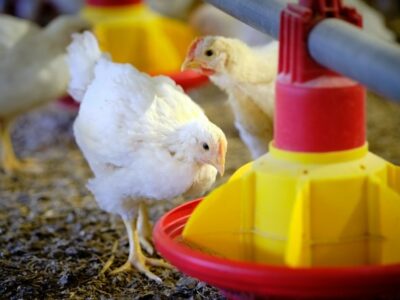



Lipids in diets for poultry
Lipid fat sources are used to reduce metabolic heat production during warmer monthsBy: Charles Starkey, Ph.D., Assistant professor, Poultry Science, Auburn University
Dietary energy has long been misunderstood from a formulation point of view. For decades, we have relied on inefficient energy determination methods such as bomb calorimetry to assess the calorie content of a known feedstuff. We, then, utilize average values and hope for the best when formulating rations for animals.
Even today, more modern techniques only get us slightly closer to our desired goals. Tools like cecatomized roosters, while very useful, do not adequately represent broilers growing during early stages of growth. Use of NIR (near infrared) ingredient analyses can have high costs when used inappropriately. Ranges in the digestible energy of carbohydrate sources are often not considered when grains age during storage and their composition changes, or their contents shift due to varietal differences and seasonal weather differences.
Lipid fat
Historically, lipid fat sources have been utilized to aid in the reduction of metabolic heat production during warmer months. However, this impact may be overcome if the fiber fraction of these diets increases, and the lipids are not digested but rather adhere to fiber fractions and are passed through the tract.
While high quality lipid sources can be extremely valuable tools for providing energy, oxidized or lower quality lipids (those high in MIU or FFA) may have the opposite effect. Research has demonstrated that oxidized fats can reduce performance, and even more importantly, cause physiological damage to the gastrointestinal enterocytes and tight junction proteins.
Intestinal health, physiology, and metabolism all play a significant role in the digestion of nutrients as well as where in the body they are utilized. If the gastrointestinal tract and the liver combined account for approximately 50% of the energy for growth, any insult to these tissues through diseases, parasites, or mycotoxins can divert energy from muscle protein accretion to immunological response and cellular replacement or repair. We must take better account of the costs of poor gastrointestinal health to our production systems and economic calculations.
Genetic challenges
In addition, we must keep up with genetic changes in modern fast growing, high-yielding broilers. The endocrinological response of satiety has changed in these genetic lines as well. Today’s broilers can consume up to 40% more of a low energy diet to achieve similar, if not greater, weight gains. To accomplish this; however, efficiency in conversion of grams of feed to grams of muscle protein gained is negatively impacted.
Furthermore, today’s broilers do not seem to want to sequester fat into abdominal pads as willingly as previous strains. Between the efficiency in protein accretion and the use of exogenous enzymes, there is a shortage of poultry fat in the current market.
While small changes in the energy content of the diet may achieve economic savings on paper, overconsumption of feed by today’s fast-growing, high-yielding genetic broiler lines will eliminate, and possibly reverse, any gains achieved.

More research needed
Additional information is still needed to better understand the benefits of different carbohydrate fractions. Research in net energy systems has not been universally accepted by nutritionists in certain areas, especially those who have enjoyed abundant grain supplies at reduced prices.
While a great deal of effort was placed into research during the 1990s to determine non-starch polysaccharide concentrations in feed ingredients, that work is now decades old, and yet, we continue to utilize those original values possessed with the knowledge that the varieties of grains as well as the composition of co-products has changed drastically.
Additionally, knowledge regarding the fermentability of specific fiber fractions and how nutritionists can utilize this information to drive production is currently in its infancy.
Energy expended during both consumption of a meal as well as during digestion is still not well understood. While we continually stress pellet quality, the throughput demands require our feed manufacturing personnel to produce what would be considered inadequate pellets.
When we have 60% fines in a feeder pan, the time and metabolic energy required for each broiler to consume a meal is dramatically increased, a fact that has been well established in prior research comparing meal form and pelleted diets. If we are losing feed efficiency due to physical energy output from the birds, we are still losing performance.
Perhaps it is time we develop more research using environmental chambers and revisit the net energy concept. At a minimum, we can use this data as a springboard to better understand the overall energy supplied by new derivations of ingredients (i.e. DDGS, restaurant grease) to our growing birds.
Additionally, we can use this information to better understand the fermentative capabilities of fiber sources that can supply energy to the intestinal tract while sparing dietary energy from lipids and starch for muscle protein accretion. Finally, this methodology can allow us to make better decisions on complete diet formulations when we do not understand how much particle size, feed form, or lipid to starch to fiber fraction ratios impact the true digestibility of the diet.
Complex answers needed
Complex diet formulations require complex answers. We should strive to obtain better more up to date information to allow us to continue to grow in knowledge. A better understanding of the energy delivered by a complete feed versus a value measured with a calorimeter can improve decision making.
Understanding the complexities of energy digested versus energy utilization as a percentage of muscle accretion allows for more efficient production. Finally, understanding the complexities of the endocrinological triggers for satiety and well as growth axis hormonal signaling for fat accretion as opposed to protein will demonstrate the most appropriate energy concentrations needed to achieve the desired productivity parameters.









